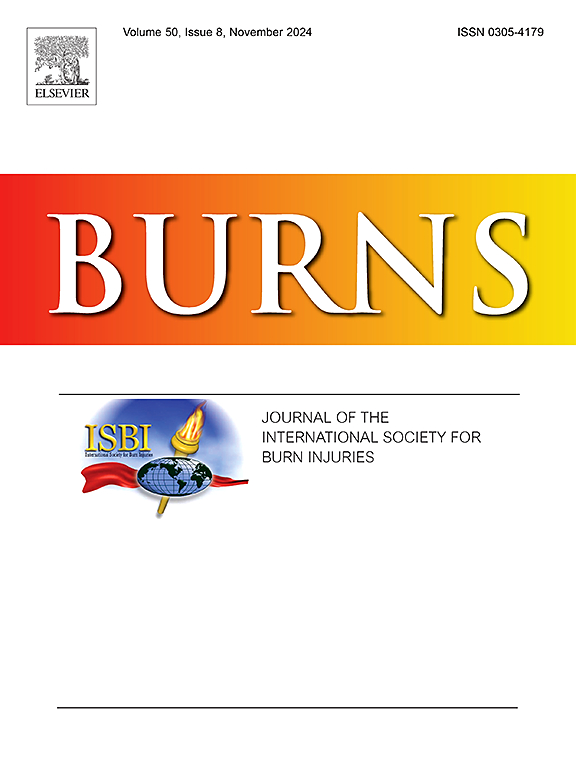IBSP通过与SKP1相互作用介导增生性瘢痕成纤维细胞的恶性行为
IF 2.9
3区 医学
Q2 CRITICAL CARE MEDICINE
引用次数: 0
摘要
aims肥厚性瘢痕(HS)是一种以异常肌成纤维细胞增殖和细胞外基质积累为特征的皮肤纤维化状况。本研究旨在阐明整合素结合唾液蛋白(IBSP)在增生性瘢痕成纤维细胞中的功能作用及其潜在机制。材料与方法通过转录组学方法筛选sibsp蛋白和wnt信号通路。为了表征IBSP在增生性瘢痕成纤维细胞中的作用,我们进行了CCK8、transwell和WB实验。结果通过转录组学筛选到sibsp蛋白和wnt信号通路。由于IBSP在增生性瘢痕成纤维细胞中的表达升高,我们进行了IBSP蛋白敲低,发现其对增殖、迁移和侵袭有显著的抑制作用。Western blotting实验表明,抑制IBSP可抑制wnt信号通路和胶原形成。随后的研究表明,IBSP可以抑制增生性瘢痕成纤维细胞中三磷酸腺苷(ATP)的产生和活性氧(ROS)水平的升高。为探讨IBSP的作用机制,采用质谱分析方法。质谱、免疫沉淀和免疫荧光结合证实IBSP与SKP1结合。值得注意的是,SKP1敲低显著减少增生性瘢痕成纤维细胞的恶性行为,包括增殖、迁移、侵袭、胶原合成和ATP产生。此外,SKP1敲低抑制wnt信号通路,同时诱导ROS的产生。结论本研究提示IBSP促进增生性瘢痕成纤维细胞的恶性过程。本文章由计算机程序翻译,如有差异,请以英文原文为准。
IBSP mediates fibroblast malignant behaviors in hypertrophic scars via interacting with SKP1
Aims
Hypertrophic scars (HS) are fibrotic skin conditions marked by abnormal myofibroblast proliferation and extracellular matrix accumulation. This study aimed to elucidate the functional effects and potential mechanisms of integrin-binding sialoprotein (IBSP) in hypertrophic scar fibroblasts.
Materials and methods
IBSP protein and wnt signaling pathway were screened by transcriptomics. To characterize the role of IBSP in hypertrophic scar fibroblasts, CCK8, transwell, and WB experiments were performed.
Results
IBSP protein and wnt signaling pathway were screened by transcriptomics. Since IBSP expression was elevated in proliferative scar fibroblasts, we performed IBSP protein knockdown, revealing a significant inhibition of proliferation, migration, and invasion. Western blotting experiments demonstrated that knockdown IBSP could inhibit wnt signaling pathway and collagen formation. Subsequent investigations indicated that IBSP knockdown reduced adenosine triphosphate (ATP) production and heightened reactive oxygen species (ROS) levels in hypertrophic scar fibroblasts. In order to investigate the potential mechanism of IBSP action, mass spectrometry analysis was performed. A combination of mass spectrometry, immunoprecipitation, and immunofluorescence verified that IBSP binds to SKP1. Notably, SKP1 knockdown markedly curtailed malignant behaviors in hypertrophic scar fibroblasts, including proliferation, migration, invasion, collagen synthesis, and ATP production. Moreover, SKP1 knockdown inhibited the wnt signaling pathway while inducing ROS production.
Conclusion
Collectively, our present study suggests that IBSP promotes the malignant process in hypertrophic scar fibroblasts.
求助全文
通过发布文献求助,成功后即可免费获取论文全文。
去求助
来源期刊

Burns
医学-皮肤病学
CiteScore
4.50
自引率
18.50%
发文量
304
审稿时长
72 days
期刊介绍:
Burns aims to foster the exchange of information among all engaged in preventing and treating the effects of burns. The journal focuses on clinical, scientific and social aspects of these injuries and covers the prevention of the injury, the epidemiology of such injuries and all aspects of treatment including development of new techniques and technologies and verification of existing ones. Regular features include clinical and scientific papers, state of the art reviews and descriptions of burn-care in practice.
Topics covered by Burns include: the effects of smoke on man and animals, their tissues and cells; the responses to and treatment of patients and animals with chemical injuries to the skin; the biological and clinical effects of cold injuries; surgical techniques which are, or may be relevant to the treatment of burned patients during the acute or reconstructive phase following injury; well controlled laboratory studies of the effectiveness of anti-microbial agents on infection and new materials on scarring and healing; inflammatory responses to injury, effectiveness of related agents and other compounds used to modify the physiological and cellular responses to the injury; experimental studies of burns and the outcome of burn wound healing; regenerative medicine concerning the skin.
 求助内容:
求助内容: 应助结果提醒方式:
应助结果提醒方式:


